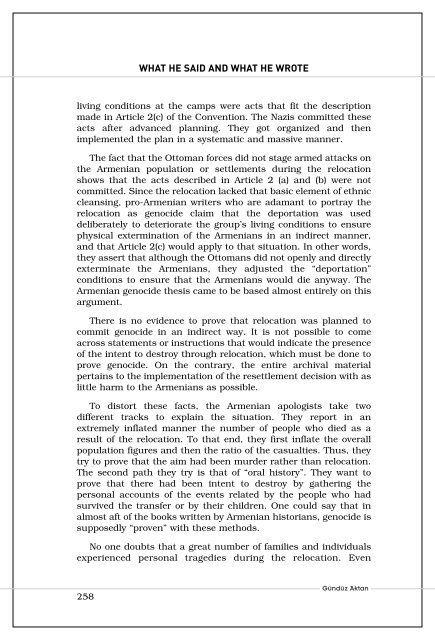gunduz-aktan-kitap-soyledikleri-ve-yazdiklari
gunduz-aktan-kitap-soyledikleri-ve-yazdiklari
gunduz-aktan-kitap-soyledikleri-ve-yazdiklari
You also want an ePaper? Increase the reach of your titles
YUMPU automatically turns print PDFs into web optimized ePapers that Google loves.
WHAT HE SAID AND WHAT HE WROTE<br />
living conditions at the camps were acts that fit the description<br />
made in Article 2(c) of the Con<strong>ve</strong>ntion. The Nazis committed these<br />
acts after advanced planning. They got organized and then<br />
implemented the plan in a systematic and massi<strong>ve</strong> manner.<br />
The fact that the Ottoman forces did not stage armed attacks on<br />
the Armenian population or settlements during the relocation<br />
shows that the acts described in Article 2 (a) and (b) were not<br />
committed. Since the relocation lacked that basic element of ethnic<br />
cleansing, pro-Armenian writers who are adamant to portray the<br />
relocation as genocide claim that the deportation was used<br />
deliberately to deteriorate the group’s living conditions to ensure<br />
physical extermination of the Armenians in an indirect manner,<br />
and that Article 2(c) would apply to that situation. In other words,<br />
they assert that although the Ottomans did not openly and directly<br />
exterminate the Armenians, they adjusted the “deportation”<br />
conditions to ensure that the Armenians would die anyway. The<br />
Armenian genocide thesis came to be based almost entirely on this<br />
argument.<br />
There is no evidence to pro<strong>ve</strong> that relocation was planned to<br />
commit genocide in an indirect way. It is not possible to come<br />
across statements or instructions that would indicate the presence<br />
of the intent to destroy through relocation, which must be done to<br />
pro<strong>ve</strong> genocide. On the contrary, the entire archival material<br />
pertains to the implementation of the resettlement decision with as<br />
little harm to the Armenians as possible.<br />
To distort these facts, the Armenian apologists take two<br />
different tracks to explain the situation. They report in an<br />
extremely inflated manner the number of people who died as a<br />
result of the relocation. To that end, they first inflate the o<strong>ve</strong>rall<br />
population figures and then the ratio of the casualties. Thus, they<br />
try to pro<strong>ve</strong> that the aim had been murder rather than relocation.<br />
The second path they try is that of “oral history”. They want to<br />
pro<strong>ve</strong> that there had been intent to destroy by gathering the<br />
personal accounts of the e<strong>ve</strong>nts related by the people who had<br />
survi<strong>ve</strong>d the transfer or by their children. One could say that in<br />
almost aft of the books written by Armenian historians, genocide is<br />
supposedly “pro<strong>ve</strong>n” with these methods.<br />
No one doubts that a great number of families and individuals<br />
experienced personal tragedies during the relocation. E<strong>ve</strong>n<br />
258<br />
Gündüz Aktan



